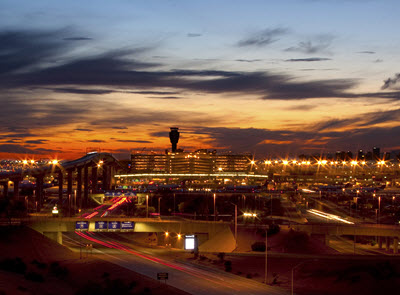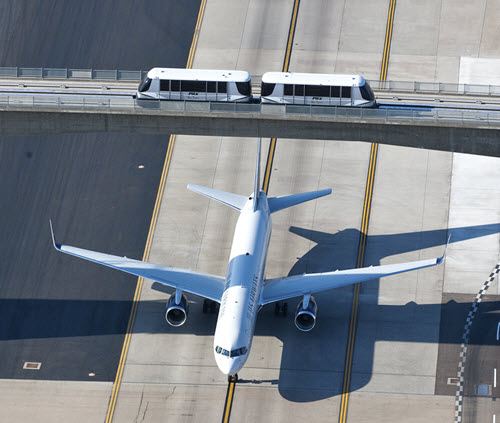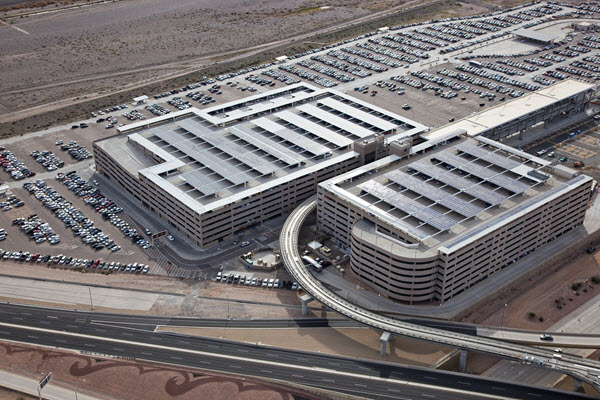EnergyCAP Senior Project Manager SJ Bergman visited Phoenix, Arizona, earlier this month as part of the City’s EnergyCAP software implementation process. Today’s guest blog will focus on energy management plans, practice, and opportunities at the Sky Harbor International Airport.

In my experience in performing ASHRAE Level 2 energy audits, I’ve seen that airports can potentially provide rich opportunities for energy efficiency. So when Paul Sylvia, Acting Energy Management Engineer for Aviation Facilities, offered to show me some of Sky Harbor International Airport’s energy saving and sustainability initiatives, I was happy to take him up on his offer. After all, Sky Harbor is “America’s Friendliest Airport”!
I met Paul at the PHX Sky Train station in Terminal 4. The PHX Sky Train® is a 24 hour, automated train that serves around 70,000 passengers every week. The short ride from the light rail station into the airport is a blast – the PHX Sky Train takes you directly over an active taxiway and the views are spectacular:

(BTW, using the PHX Sky Train and Phoenix’s light rail system, I was able to get around Phoenix without needing a car at all).
Paul told us that Sky Harbor facilities staff are working hard on two fronts:
- Reducing energy consumption
- Moving toward sustainable fuels
However, they face an additional challenge. Airports are subject to safety and security regulations that may not be optimized for energy efficiency.
The airport has a high awareness of their energy usage, and has installed electric submeters on all their buildings and large equipment items. They are in the process of implementing a state-of-the-art Integrated Building System to monitor real-time energy consumption, with integrated security and fire alarms. The system not only provides alerts; it displays the correct protocols for resolving alarm conditions to streamline maintenance response to issues.
Airports have some unique equipment that can be resistant to energy efficiency. Baggage handling conveyors can be huge energy hogs. Sky Harbor has a baggage handling control system with real time display to assist in efficiently routing bags, shutting down idle sections, and finding and resolving jams. They have installed variable frequency drives (VFDs) on all conveyor motors, as well as low-friction conveyor belts. This may not sound like much in terms of energy saving potential, but in just one small section of the airport there are over seven miles of baggage conveyors!
Sky Harbor is currently conducting an ASHRAE Level 2 audit, plus energy modeling of their HUGE chiller plant. Aviation facilities staff are eager to see what energy conservation measures they can tackle next. LED lighting throughout the terminal is high on the list.
Sky Harbor has the benefit of all that beautiful AZ sun, and they are taking advantage of it. They installed a 5.4 megawatt (yes, that’s MW!) solar PV array on their parking garages, which meets about half of the electricity demand at the Rental Car center and Economy parking areas:

It was great to see all the energy efficiency and sustainability activity at Sky Harbor International Airport, and it’s our privilege to welcome them and the City of Phoenix to the EnergyCAP family!
Phoenix has joined the Better Buildings Challenge, and EnergyCAP will help the City to meet their reduction goal of 20% below the 2009 baseline by 2020.
We held two training sessions during our visit to introduce the City’s department managers, facilities staff, and accounting staff to their new EnergyCAP database. It was great working with Tina Imig, Energy Billing Analyst, and Dimitrios Laloudakis, Energy Manager, along with many other new friends.
{{cta(‘1d34a06f-79e8-45c0-ab9c-1dc6ea1e407e’)}}
 Best-in-class portfolio-level energy and utility bill data management and reporting.
Best-in-class portfolio-level energy and utility bill data management and reporting.
 Real-time energy and sustainability analytics for high-performance, net-zero buildings.
Real-time energy and sustainability analytics for high-performance, net-zero buildings.
 A holistic view of financial-grade scope 1, 2, and 3 carbon emissions data across your entire business.
A holistic view of financial-grade scope 1, 2, and 3 carbon emissions data across your entire business.
 Energy and sustainability benchmarking compliance software designed for utilities.
Energy and sustainability benchmarking compliance software designed for utilities.





